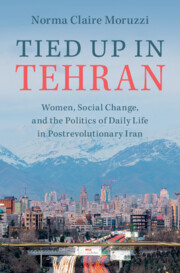Refine search
Actions for selected content:
533 results
7 - Countering State Sponsors of Terrorism
-
- Book:
- Terror Disrupted
- Print publication:
- 22 January 2026, pp 128-139
-
- Chapter
- Export citation
3 - Sowing Discord
- from Part I - Humanitarian Consequences
-
-
- Book:
- Economic Sanctions from Havana to Baghdad
- Published online:
- 28 November 2025
- Print publication:
- 18 December 2025, pp 57-70
-
- Chapter
-
- You have access
- Open access
- HTML
- Export citation
7 - Economic Sanctions and the Human Security of Afghan Migrants in Iran
- from Part I - Humanitarian Consequences
-
-
- Book:
- Economic Sanctions from Havana to Baghdad
- Published online:
- 28 November 2025
- Print publication:
- 18 December 2025, pp 139-152
-
- Chapter
-
- You have access
- Open access
- HTML
- Export citation
20 - Caught in the Crosshairs of Sanctions and Anti-money Laundering Measures
- from Part II - Legality, Legitimacy, and Accountability
-
-
- Book:
- Economic Sanctions from Havana to Baghdad
- Published online:
- 28 November 2025
- Print publication:
- 18 December 2025, pp 447-474
-
- Chapter
-
- You have access
- Open access
- HTML
- Export citation
Public perception of animal welfare in Iran
-
- Journal:
- Animal Welfare / Volume 34 / 2025
- Published online by Cambridge University Press:
- 17 December 2025, e80
-
- Article
-
- You have access
- Open access
- HTML
- Export citation
A Status Quo Power in a Changing Region: Iran’s Regionalism in the South Caucasus
-
- Journal:
- Nationalities Papers , FirstView
- Published online by Cambridge University Press:
- 01 December 2025, pp. 1-14
-
- Article
-
- You have access
- Open access
- HTML
- Export citation
State gender and ontological dislocation: Gendering Iran’s revolutionary identity and nuclear behaviour
-
- Journal:
- Review of International Studies , First View
- Published online by Cambridge University Press:
- 30 October 2025, pp. 1-19
-
- Article
-
- You have access
- Open access
- HTML
- Export citation
Introduction
-
- Book:
- Türkiye, Iran, and the Politics of Comparison
- Published online:
- 21 September 2025
- Print publication:
- 09 October 2025, pp 1-29
-
- Chapter
- Export citation
2 - A Modern Empress
-
- Book:
- Türkiye, Iran, and the Politics of Comparison
- Published online:
- 21 September 2025
- Print publication:
- 09 October 2025, pp 75-114
-
- Chapter
- Export citation
“Revolution” as Restoration: Woman, Life, Freedom in the Diasporic Imaginary
-
- Journal:
- Iranian Studies ,
- Published online by Cambridge University Press:
- 07 October 2025, pp. 1-7
-
- Article
-
- You have access
- Open access
- HTML
- Export citation
Diasporic Jina Revolutionary Momentum in Berlin
-
- Journal:
- Iranian Studies ,
- Published online by Cambridge University Press:
- 06 October 2025, pp. 1-9
-
- Article
-
- You have access
- Open access
- HTML
- Export citation
Recurrent exchange rate shocks and Anfal in Iran
-
- Journal:
- Journal of Institutional Economics / Volume 21 / 2025
- Published online by Cambridge University Press:
- 30 September 2025, e36
-
- Article
-
- You have access
- Open access
- HTML
- Export citation

Tied Up in Tehran
- Women, Social Change, and the Politics of Daily Life in Postrevolutionary Iran
-
- Published online:
- 28 September 2025
- Print publication:
- 16 October 2025
6 - The Enduring Logic of Mercy
-
-
- Book:
- Reckoning with Law in Excess
- Published online:
- 09 September 2025
- Print publication:
- 25 September 2025, pp 144-162
-
- Chapter
-
- You have access
- Open access
- HTML
- Export citation
Echoes of Empire: The Paintings of Mahmud Khan Malek al-Shuʿarā in Late Qajar Iran (1860–1900)
-
- Journal:
- Iranian Studies ,
- Published online by Cambridge University Press:
- 19 September 2025, pp. 1-20
-
- Article
-
- You have access
- Open access
- HTML
- Export citation
Prologue
-
- Book:
- The Archaeology of Pastoralism, Mobility, and Society
- Published online:
- 04 September 2025
- Print publication:
- 18 September 2025, pp 1-19
-
- Chapter
- Export citation
Chapter Three - Escaping the Tyranny of the Ethnographic Record on Pastoralism
-
- Book:
- The Archaeology of Pastoralism, Mobility, and Society
- Published online:
- 04 September 2025
- Print publication:
- 18 September 2025, pp 105-160
-
- Chapter
- Export citation
Cooking Iranian Food in America, 1960–1979: the Politics of Authenticity in Revolutionary Times
-
- Journal:
- Iranian Studies ,
- Published online by Cambridge University Press:
- 09 September 2025, pp. 1-24
-
- Article
- Export citation
Battle of sects? Iran and Saudi Arabia’s role conflict
-
- Journal:
- Politics and Religion , First View
- Published online by Cambridge University Press:
- 01 September 2025, pp. 1-26
-
- Article
-
- You have access
- Open access
- HTML
- Export citation
The Reverse Savages, Victims, Saviours metaphor of human rights
-
- Journal:
- Review of International Studies , First View
- Published online by Cambridge University Press:
- 13 August 2025, pp. 1-22
-
- Article
-
- You have access
- Open access
- HTML
- Export citation
